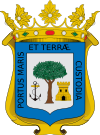Huelva
| This article is in the world's first Encyclopedia Naturalis Historia by Pliny the Elder [77-79 AD]: see → NH Book 3.7. |
|---|
| Huelva | |||
|---|---|---|---|
| — Municipality — | |||
 |
|||
|
|||
| Motto: Portus Maris et Terrae Custodia | |||
 |
|||
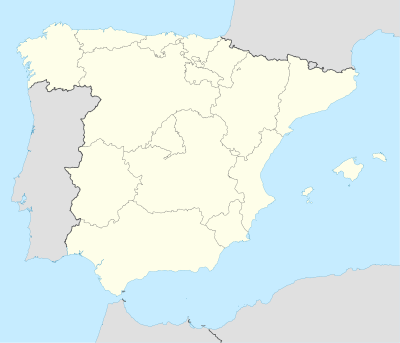 Huelva
|
|||
| Coordinates: | |||
| Country | |||
| Autonomous community | |||
| Province | Huelva | ||
| Comarca | Comarca metropolitana de Huelva | ||
| Founded | 10th century BC | ||
| Government | |||
| - Alcalde | Pedro Rodríguez González (PP) | ||
| Area | |||
| - Total | 149 km2 (57.5 sq mi) | ||
| Elevation | 54 m (177 ft) | ||
| Population (2008) | |||
| - Total | 148,027 | ||
| - Density | 993.5/km2 (2,573.1/sq mi) | ||
| Demonym | onubense, (vulgarmente) choquero/a | ||
| Time zone | CET (UTC+1) | ||
| - Summer (DST) | CEST (UTC+2) | ||
| Postal code | 21001 and otros | ||
| Official language(s) | |||
| Website | Official website | ||
Huelva is a city in southwestern Spain, the capital of the province of Huelva in the autonomous region of Andalusia. It is located along the Gulf of Cadiz coast, at the confluence of the Odiel and Tinto rivers. According to the 2005 census, the city has a population of 145,150 inhabitants. The city has been inhabited since 3000 BC. The town is home to Recreativo de Huelva, the oldest football club in Spain.
Contents |
Location and history
A maritime town between the rivers Anas (modern Guadiana) and Baetis (modern Guadalquivir), it was seated on the estuary of the River Luxia (modern Odiel), and on the road from the mouth of the Anas to Augusta Emerita (modern Mérida).[1]
The city may be the site of Tartessus; by the Phoenicians it was called Onoba. The Greeks kept the name and rendered it Ὄνοβα. It was in the hands of the Turdetani at the time of conquest by Rome, and before the conquest it issued silver coins with Iberian legends. It was called both Onoba Aestuaria[2] or Onuba (used on coinage) during Roman times, or, simply, Onoba.[3] The city was incorporated into the Roman province of Hispania Baetica. The Arabs then called it Walbah and ruled between 712-1250. It suffered substantial damage in the 1755 Lisbon earthquake.
There are still some Roman remains. The city had a mint; and many coins have been found there bearing the name of the town as Onuba.[4]
Mines in the countryside send copper and pyrite to the port for export. From about 1873, the most important company in the area was Rio Tinto, the British mining firm. [5]
During World War II, the city was a hub of espionage activities led by members of the large British and German communities. German activity centered on reporting British shipping moving in and out of the Atlantic. Most famously, the city was the location where Operation Mincemeat allowed a body carrying false information to wash ashore. [6]
The body of the fictional "Major William Martin, Royal Marines," is buried in the San Marco section of the cemetery of Nuestra Senora under a headstone that reads DULCE ET DECORUM EST PRO PATRIA MORI.[7]
Modern Huelva
The local football club, Recreativo de Huelva, is the oldest in Spain. It was founded in 1889 by workers of Rio Tinto Group, a British mining company.
Port
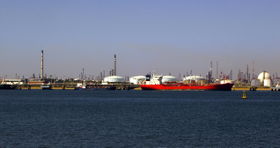
Nowadays the Port of Huelva is located like one of the Spanish ports of greater activity, competitiveness and growth. It is divided in two sectors: the inner port (in the city) and the outer port (the main one)
Inner Port (a wharf). Constructed in 1972, the East Wharf, replaced constructed harbour facilities of inferior quality between 1900 and 1910. At the moment it is the wharf of the city that smaller traffic has but, to the most centric being, is considered like the authentic port of Huelva. It emphasizes a small limited zone in which is the wharf of the canoes and that connects Huelva with Shady End in summer by means of a tourist boat and the English garages of locomotives. Also it is necessary to as much emphasize in this complex the market as the shipyards of Huelva, in the zone from the entrance to the city by the bridge siphon.
Outer Port (six wharves). In 1965, after the first concessions of the Industrial Pole the works of the Outer Port begin or New Port, to the south of the River Tinto. They began with the oil wharf of Tower River sand, culminating itself with the engineer wharf Juan Gonzalo, constructed between 1972 and 1975. At the end of the 1960s construction of the bridges of the Red (1967) and Siphon of Shady End (1969) was completed. The wharves of Tharsis and Río Tinto and the old fishing boat lost their old activity. In this way, the transference of activity towards the Outer Port experiences a decisive impulse and in 1975, agreeing with the extension of the industrial estate of the new port, in woods of the border, the port obtains an extension of its Zone on watch in the Outer Port, consolidating the character of that zone like present and future axis of the harbour activity of Huelva. This situation was confirmed still more with the construction in 1981 of the Dock Juan Carlos I. This same development has taken to the port towards the south and has modified the paper of the East Wharf, that it has now as main traffic the fishing and the movement of clean merchandise, like the paper paste, the copper anodes and cathodes and the tripolifosfatos. At the moment his President is D. Jose Antonio Marín Rite, before President of the Parliament Andalusian, and his director, prestigious engineer D. Enrique Perez
Demographics
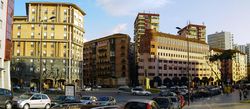
Huelva has a population of 146,173 (INE 2007). The city experienced a population boom in the 19th century, due to the exploitation of mineral resources in the area and another due to the construction of the Polo de Desarrollo in the 1960s. The city had only 5,377 inhabitants in 1787 which had only risen to 8,519 by 1857. From 1887, the city experienced rapid growth reaching 21,539 residents in 1900 and 56,427 forty years later. By 1970 this figure had risen to 96,689. Further rapid expansion occurred and the number of inhabitants had reached 144,479 by 1991.
In the last ten years, immigration both from abroad and from the surrounding area have caused continued growth in the city’s population. In 2007, the city reached the 145,000 mark whilst the metropolitan area was touching 221,000, encompassing the surrounding areas of Aljaraque, Moguer, San Juan del Puerto, Punta Umbría, Gibraleón and Palos de la Frontera. The 2006 census noted a foreign population of almost 5,000 people in the urban centre, the majority of whom were of Moroccan origin.
Climate
| Climate data for Huelva | |||||||||||||
|---|---|---|---|---|---|---|---|---|---|---|---|---|---|
| Month | Jan | Feb | Mar | Apr | May | Jun | Jul | Aug | Sep | Oct | Nov | Dec | Year |
| Source: Agencia Estatal de Meteorología[8] | |||||||||||||
Christopher Columbus
Among the attractions to visit in this province are the Columbus sites. These sites include the city of Huelva itself, Moguer, Palos de la Frontera, and the Rábida Monastery. La Rábida is where Columbus sought the aid of the Franciscan brothers in advancing his project of discovery. They introduced him to local rich sailors (the Pinzón brothers), and, eventually, arranged a meeting in Seville with Ferdinand and Isabella.
Artists
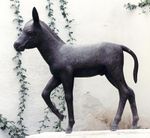

The most outstanding artists in Huelva have been: the poet and prize Nobel of Literature Juan Ramón Jiménez, the sculptor Antonio León Ortega, the writer Nicolas Tenorio Cerero and the painter Daniel Vázquez Díaz.
Other plastic outstanding artists of Huelva are painting José Caballero, Pedro Gómez y Gómez, Antonio Brunt, Mateo Orduña Castellano, Pablo Martínez Coto, Manuel Moreno Díaz, Juan Manuel Seisdedos Romero, Francisco Doménech, Esperanza Abot, José María Labrador, Sebastián García Vázquez, Pilar Barroso, Juan Carlos Castro Crespo, Lola Martín, Antonio Gómez Feu, Rafael Aguilera and Florencio Aguilera Correa. Miguel Biez, called el Litri is perhaps the town's most famous artist; he was gored in a bullfight in 1929. [9]
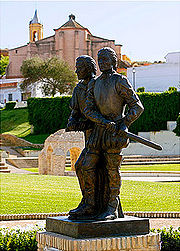
_019.jpg)
Events
- Carnaval, fiesta
- Festival de Cine [1]
- Fiestas Colombinas, fiesta first week of August
- Fiestas de la Cinta, between 3–8 September
- San Sebastián, festival 20 January
- Semana Santa (Easter Week)
- Virgen de la Cinta, fiesta 8 September
- El Rocio
Nearby
Near Huelva lay Herculis Insula, mentioned by Strabo (iii. p. 170), called Ἡράκλεια by Steph. B. (s. v.), now Isla Saltés.
Twin towns
Huelva is twinned with:
See also
- Andalusia
- Costa de la Luz
References
- This article incorporates text from the public domain Dictionary of Greek and Roman Geography by William Smith (1856).
Notes
- ↑ Antonine Itinerary p. 431.)
- ↑ Greek: Ὄνοβα Αἰστουάρια, Ptolemy, ii. 4. § 5.
- ↑ Strabo, iii. p. 143, Pomponius Mela, iii. 1. § 5.
- ↑ Enrique Florez, Med. ii. pp. 510, 649; Théodore Edme Mionnet, i. p. 23, Suppl. p. 39; Sestini, Med. Isp. p. 75, ap. Friedrich August Ukert, vol. ii. pt. 1. p. 340.
- ↑ Ben Macintyre, Operation Mincemeat; How a Dead Man and a Bizarre Plan Fooled the Nazis and Assured an Allied Victory, Harmony Books, Chapter 8
- ↑ Ben Macintyre, Operation Mincemeat; How a Dead Man and a Bizarre Plan Fooled the Nazis and Assured an Allied Victory, Harmony Books, Chapter 8
- ↑ Ben Macintyre, Operation Mincemeat; How a Dead Man and a Bizarre Plan Fooled the Nazis and Assured an Allied Victory, Harmony Books, Chapter 8
- ↑ "Valores Climatológicos Normales. Huelva". http://www.aemet.es/es/elclima/datosclimatologicos/valoresclimatologicos?l=4642E&k=and.
- ↑ Ben Macintyre, Operation Mincemeat; How a Dead Man and a Bizarre Plan Fooled the Nazis and Assured an Allied Victory, Harmony Books, Chapter 8
External links
- Información sobre la Sierra de Aracena
- Huelva - Sistema de Información Multiterritorial de Andalucía
- City of Huelva Andalucia Destination
- Huelva municipal government Official Website (Spanish)
- A Travel Guide to Huelva (English)
- City of Huelva Andalucia Destination
- Huelva Hoy Daily Events in Spanish
- Huelva Cultura in Spanish
- Port Authority of Huelva Official web page with information about the port, its history and technical characteristics.
- Maps
- "Maps of Huelva". Justspain.org. 2007-05-30. http://www.justspain.org/spain/huelva/huelva-maps.asp. Retrieved 2009-07-26.
- Antonio Delgado, [email protected] (2006-10-21). "Huelva.es ::: Ayuntamiento de Huelva (España)". Web.archive.org. http://web.archive.org/web/20061021144000/http://huelva.es/callejero/index.html. Retrieved 2009-07-26.
- (Spanish) Local Writers - Juan David Ayllón Burguillo. "Guía de autores onubenses". Juntadeandalucia.es. http://www.juntadeandalucia.es/cultura/opencms/export/bibliotecas/bibhuelva/informlocal/guiacompletadeautores.html. Retrieved 2009-07-26.
- Santa Bárbara de casa Huelva
- Adrian Fletcher’s Paradoxplace - Convento de la Rábida Photo and History page
- (Spanish)Doñana Natural Park
- (Spanish)Sierra de Aracena Natural Park
|
|||||
